
|
Roussillon and its Surroundings:
the Setting for Lisette's List
|

|
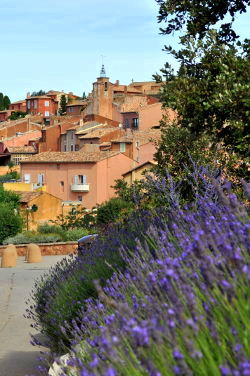
|
|
Image© Marcia M. Mueller
|

In Lisette's List, Camille Pissarro says to Pascal, speaking of Pontoise, "Everything here moves me, makes me tender....Isn't there a hunger in every human being, painter or not, to find a place in the world that gives to him so richly that he wants to honor it by giving back a thing of worth?" That's the way I felt about Roussillon my first visit of two hours in 2010, and again during my second visit of two weeks in 2011. In short, I was enchanted. I would hope that the Roussillonnais who come across this book would feel that I have honored their village with a commemoration worthy of its beauties and its contribution to painting..
|

|
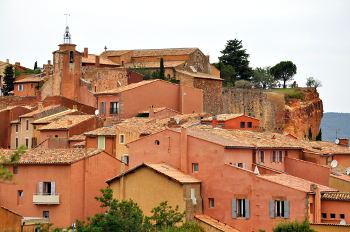
|
|
Image© Marcia M. Mueller
|

The Village:
Not to be confused with Roussillon, the region in the province of Languedoc lying west of Avignon, the village of Roussillon de Provence, lies 35 miles east of Avignon, the last three miles ascending the 900 foot perch of ochre cliffs. Its stepped houses show off its harmonious hues of golden-ochre, salmon, red- and rosy-ochre.
|
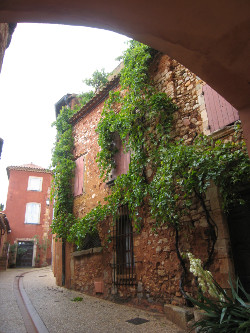
|
|
Image© Susan Vreeland
|

Roussillon has been granted the national status of "One of the Most Beautiful Villages in France." Both hot sun and cold mistral, the fierce wind racing down from the Alps necessitating thick cypress hedges that van Gogh found so picturesque, are its identifying marks.
|
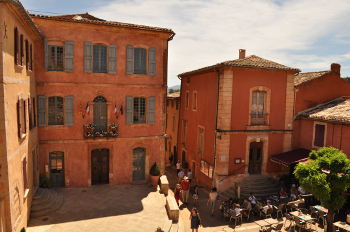
|
|
La Mairie: Image© Marcia M. Mueller
|

La Mairie, also called a hôtel de ville but not in the Western sense of a hotel, is in the main square, place de la Mairie, and serves as the offices of the mayor and the town council.
|
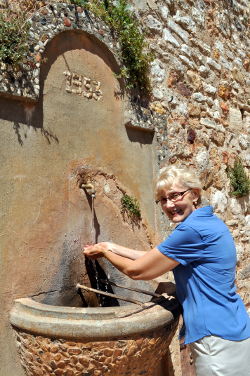
|
|
Wash Basin in place de la Mairie: Image© Marcia M. Mueller
|

It is true that electricity and plumbing for the entire population came late to this isolated village, though not quite so late as I infer in the novel. As recently as the mid-1950's one man served Roussillon as its only plumber, electrician, and postal clerk.
|
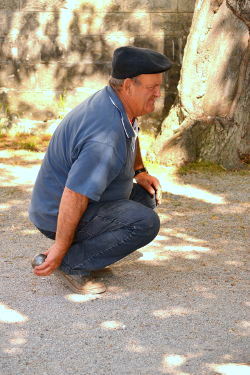
|
|
Crouching Boules Player,
Image© Marcia M. Mueller
|

The People:
France's illusive north-south divide, "la ligne Saint-Malo-Genève"
gave rise to two stereotypes. Northerners in general, and specifically Parisians, tall, thin, and fair, were considered rational, cultured, sophisticated, and reserved, while the ethnotype of the Méridionaux, people from the Midi, the geographical area to the south consisting largely of Provence, was the antithesis: short, stout, dark-haired, bronzed, coarse, and prone to explosive passion and impetuousness (consider Bernard) as well as buffoonery (consider Maurice).
|
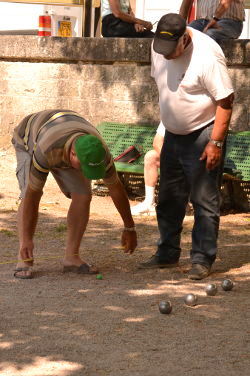
|
|
Measuring Boule to Cork, Image© Marcia M. Mueller
|

According to conventional opinion, Parisian men spend their afternoons in cafès. Provençal men spend theirs on the boules (pétanque) terrain tossing steel balls and arguing about their landing spots. In the worst application of the stereotype, northerners were viewed as civilized; southerners as simple-minded, barbaric, uncultured primitives.
This southern stereotype was burlesqued by writer Alphonse Daudet (1840-1897), himself a Méridional who made his literary career in Paris with his creation of Tartarin, the rambunctious, hot-headed, naïve small-town patriot in Provence who went around Paris displaying his Provençal taillole, the red sash wrapped around his paunchy middle region. In similar fashion, I have burlesqued Maurice, complete with taillole. Nonetheless, Cézanne, a true southerner, was known to have flaunted his taillole in Paris too. In fact, with his artistic celebration of the culture, terrain, and crafts of the South, Cézanne joined Daudet in the Félibrist movement that celebrated Provençal crafts, art, literature, and countryside. As a result, "previously despised provincial uncouthness eventually stood as a sign of the regenerative vigor represented by the provinces."¹
|

|
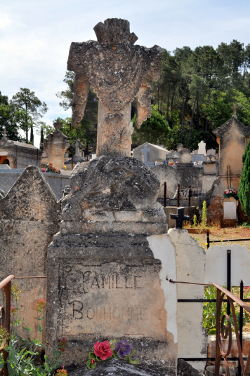
|
|
Tomb of Famille Bonhomme,
Image© Marcia M. Mueller
|

In the 1946 the population of the commune (i.e. village and immediate surroundings) of Roussillon was 780, and dropped to 700 in the 1960's. ²
Today it has 1300 permanent residents. Interestingly, André Bonhomme, the son of Aimé Bonhomme the second mayor in the novel whose family tomb you see here, is the current tourist office director largely responsible for the development of Roussillon into a tourist destination and art colony. Gisèle Bonnelly, surely a relative of Madame Bonnelly of the novel, is the current mayor.
|
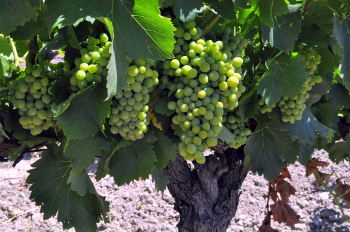
|
|
Grapevine at Harvest Time,
Image© Marcia M. Mueller
|

During the Occupation, to escape Nazis hunting him for his Resistance activity in Paris, Samuel Beckett did in fact hide in Roussillon and pick grapes in the vendange for Madame Bonnelly, and probably used the outbuildings of the Bonnelly vineyard to store explosives for the Resistance. There, waiting for the war and Occupation to end, he wrote the play Waiting for Godot.
|
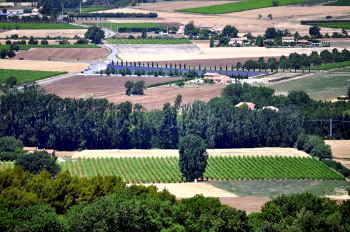
|
|
Vineyards and Lavender below Roussillon,
Image© Marcia M. Mueller
|

The Surroundings:
The terrain surrounding Roussillon, called the Vaucluse, is largely a Natural Regional Park of the Luberon with scattered pine forests, except for the farms and orchards, small in size because the rocky ground cannot support large-scale agriculture.
|
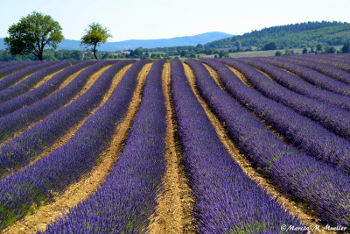
|
|
Provence Lavande (Lavender Fields),
Image© Marcia M. Mueller
|

Vineyards, cherry and peach orchards, wheat fields, melon and asparagus plots, and lavender mounds are all protected by windbreaks and nourished by canals.
|
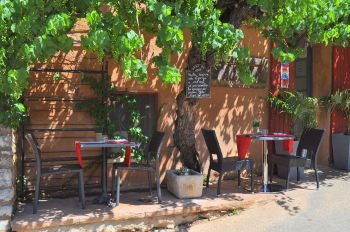
|
|
Roussillon Café, Image© Marcia M. Mueller
|

Perched on summits, clinging to steep slopes, or tucked in valleys are the villages of Gordes, Sault, St. Saturnin-lès-Apt, Bonnieux, Gault, and Fontaine de Vaucluse with its ancient, moss-draped waterwheel.
|
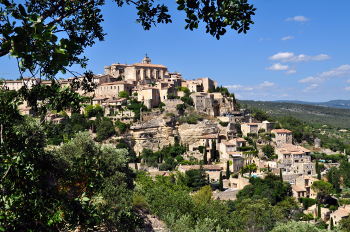
|
|
Gordes, Image© Marcia M. Mueller
|

Except for throngs of tourists, the village of Gordes, perched on a rock 635 meters high, nine kilometers west of Roussillon, is quiet now--that is to say, quiet compared to the German shelling that destroyed most of the village and massacred much of its population as retaliation against the fierce Resistance activity centered there, which subsequently won Gordes the Croix de Guerre. Fortunately the medieval arcades, the imposing chateau now used for concerts and art exhibitions, and the church suffered little damage. Residential areas have been carefully restored, and the village is thriving today.
|

|
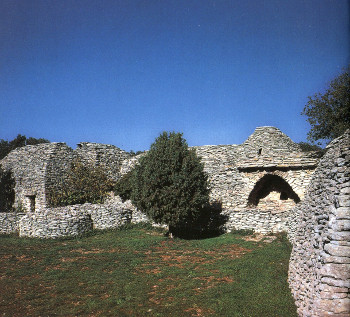
|
|
Village of Bories
|

Three kilometers from Gordes, the Village of the Bories is representative of a long tradition of dry-stone constructions on the limestone plateau of Provence and Languedoc, estimated to have been built in the late Neolithic Age, (about 2000 years before Christ). Single bories situated by themselves were thought to be temporary shelters and served to keep stores or agricultural tools. Larger bories existed as permanent dwellings grouped together in hamlets. Inside, there had once been benches, alcoves, cupboards, bread ovens and chimneys. Outside, there were dry-stone haybarns, pigsties, presses, wine vats, and tanks dug into the rock. The hamlets were fortified by high stone walls to protect from bandits and wolves.
|
|
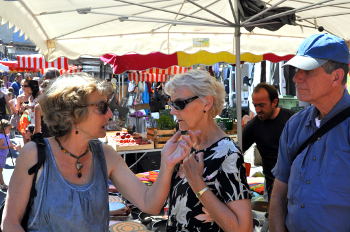
|
|
Making Friends in the Marketplace,
Image© Marcia M. Mueller
|

The Market town of Apt was created in 45 B.C. on orders from Julius Caesar. Although habitation of the riverside site dates back to prehistoric times, the long Roman occupation is still evident in the ampitheater and the public baths. The town is surrounded by ruins of walls erected in the Middle Ages to keep out the plague. A thriving Saturday market which has been going on for 800 years takes over a network of streets and plazas every Saturday. The town is known for its glazed fruit candies, its marzipan, its local agricultural products of olives, olive oils, honey, fresh fruit and vegetables, as well as a wide array of colorful Provençal fabrics, tablecloths, soaps, and items made of straw.
|
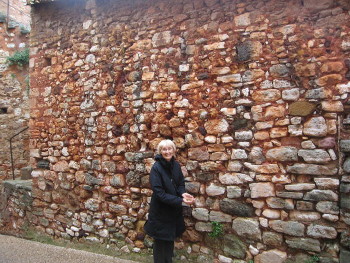
|
|
A Wall in Roussillon Image© Kip Gray
|

There was not one thing in Roussillon, even this wall, that I did not find interesting.
|

Sources:
¹Nina Maria Athanassoglou-Kallmyer, Cézanne and Provence: The Painter in His Culture. Chicago: University of Chicago Press, 2003.
²Laurence Wylie, Village in the Vaucluse. Cambridge: Harvard University Press, 1957,1974.
Marcia M. Mueller, the fine art photographer whose work you see here is offering for sale a special 2015 Lisette's List calendar. Find out more by visting www.MarciaMueller.com

|
|















